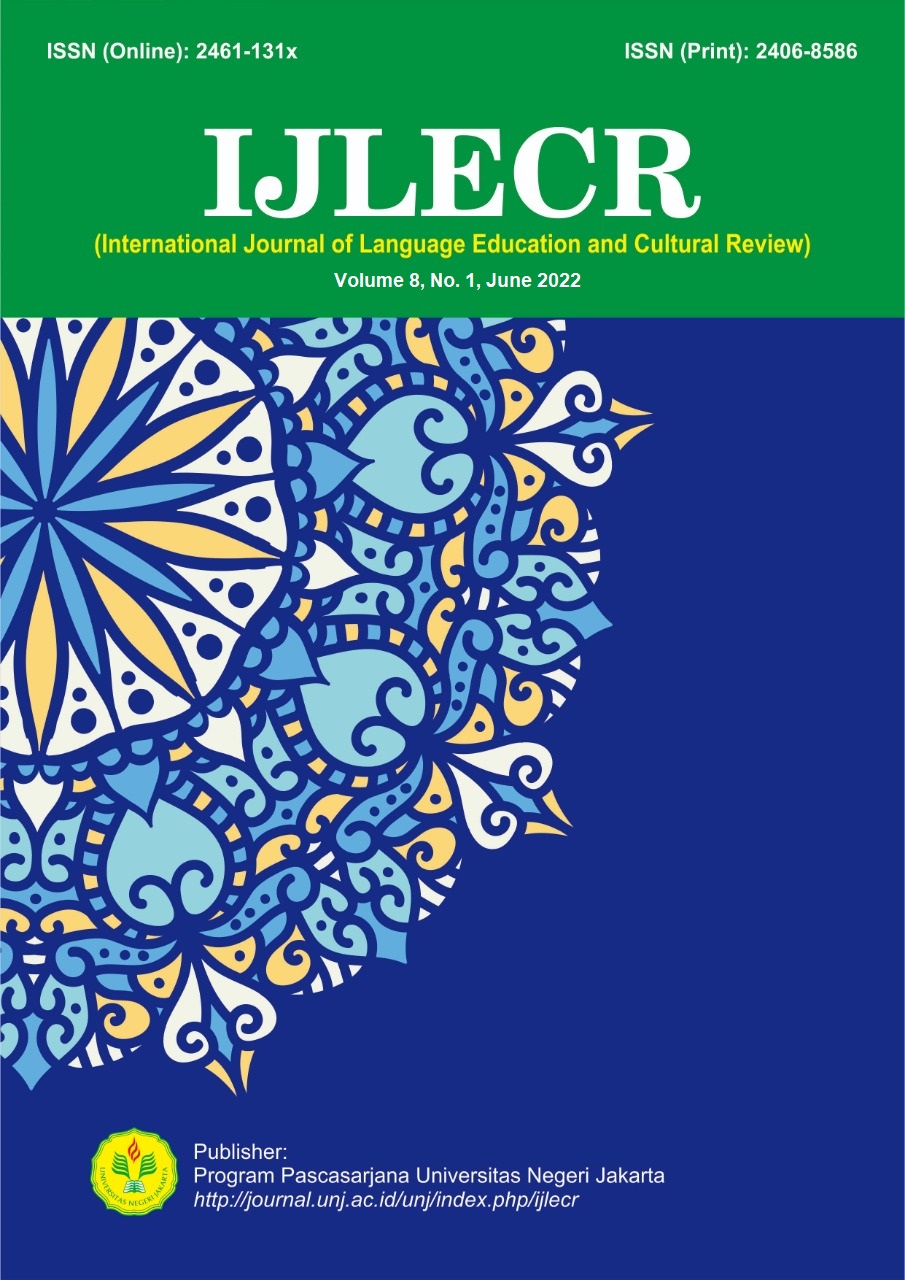STUDENTS’ PERCEPTION ON LEARNING HEUTAGOGY IN THE ENGLISH FOR YOUNG LEARNER
DOI:
https://doi.org/10.21009/IJLECR.081.01Keywords:
students perception heutagogy, English for young learnerAbstract
To attract the attention of students as learners, teachers should use an approach that is in accordance with the characteristics of students. Students as generation z or digital natives, have a great interest in the digital world. Therefore, the process of learning and teaching can get out of the traditional zone by using the heutagogy method. This heutagogy method is applied to students who take English for Young learners. The results obtained from 85 students' answers to the questionnaire about students' perceptions of learning using heutagogy showed positive results. Students respond well to heutagogy learning. Heutagogy is expected to be a teaching choice for students later.
References
Astutik, Y., & Aulina, C. N. (2017). Metode Total Physical Response (TPR) pada Pengajaran Bahasa Inggris Siswa Taman Kanak-Kanak. Jurnal Pendidikan Bahasa Dan Sastra, 17(2), 196–207. https://doi.org/10.17509/bs_jpbsp.v17i2.9658
Budiyono, B. (2020). Inovasi Pemanfaatan Teknologi Sebagai Media Pembelajaran di Era Revolusi 4.0. Jurnal Kependidikan: Jurnal Hasil Penelitian Dan Kajian Kepustakaan Di Bidang Pendidikan, Pengajaran Dan Pembelajaran, 6(2), 300–309. https://e-journal.undikma.ac.id/index.php/jurnalkependidikan/article/view/2475
Buwono, S., & Dewantara, J. A. (2020). Hubungan Media Internet, Membaca, dan Menulis dalam Literasi Digital Mahasiswa. Jurnal Basicedu, 4(4), 1186–1193.
Chaeruman, U. A., Wibawa, B., & Syahrial, Z. (2018). Determining the Appropriate Blend of Blended Learning : A Formative Research in the Context of Spada-Indonesia. American Journal of Educational Research, 6(3), 188–195. https://doi.org/10.12691/education-6-3-5
Chan, C. G., Embi, M. A. Bin, & Hashim, H. (2019). Primary School Teachers ’ Readiness Towards Heutagogy and Peeragogy. Asian Education Studies, 4(1), 11–21. https://doi.org/10.20849/aes.v4i1.602
Chun, & Ho, M. C. S. (2018). Conceptualizing teachers ’ entrepreneurial behavior : An exploratory review. International Journal of Liberal Arts and Social Science, 6(1), 14–28.
Hakim, L. N., & Solihati, T. A. (2021). Sosialisasi English for Young Learners (EYL) bagi Guru Sekolah Dasar di Gugus II Kecamatan Ciamis. Aksiologiya : Jurnal Pengabdian Kepada Masyarakat, 5(4).
Hapsari, S. A., & Pamungkas, H. (2019). Pemanfaatan Google Classroom Sebagai Media Pembelajaran Online di Universitas Dian Nuswantoro. WACANA, 18(2), 225–233.
Jaleniauskienė, E., Leščinskij, R., & Jucevičienė, P. (2019). Development of Collaboration in the English for Specific Purposes Courses: Opportunities and Challenges. THE JOURNAL OF TEACHING ENGLISH FOR SPECIFIC AND ACADEMIC PURPOSES, 7(3), 311–327
Juliah, D., Musthafa, B., & Wirza, Y. (2021). Home Literacy Environment to Support the Teaching English to Young Learner (TEYL). Proceedings of the Thirteenth Conference on Applied Linguistics (CONAPLIN 2020) Home, 546, 83–89.
Khusnaini, N. (2019). The Analysis of Teacher Talk and The Characteristic of Classroom Interaction in English for Young Learner. Journal of English Language Teaching, 8(2), 166– 174.
Lassoued, Z., Alhendawi, M., & Bashitialshaaer, R. (2020). An Exploratory Study of the Obstacles for Achieving Quality in Distance Learning during the COVID-19 Pandemic. Education Sciences, 10(232), 1–13.
Lolita, Y., Boeriswati, E., & Lustyantie, N. (2020). The Impact of Computer Assisted Language Learning (CALL) Use of English Vocabulary Enhancement. Linguistic, English Education and Art (LEEA) Journal, 4(1), 206–221.
Maman, M. (2020). Meningkatkan Keterampilan Guru Membuka dan Menutup Pelajaran Melalui Sharing Pengalaman Mengajar Dalam Forum KKG. J-KIP (Jurnal Keguruan Dan Ilmu Pendidikan) Vol., 1(2), 99–104.
Marcut, I. G., & Chisiu, C. M. (2018). Heutagogy – An Appropriate Framework For Computer Aided Learning Course With Post-Graduate Teacher Students. Journal Plus Education, XXI(Special Issue), 203–215.
Moore, R. L. (2020). Developing lifelong learning with heutagogy : contexts , critiques , and challenges critiques , and challenges. Distance Education, 41(3), 381–401. https://doi.org/10.1080/01587919.2020.1766949
Pratiwi, E. W. (2020). Dampak COVID-19 Terhadap Kegiatan Pembelajaran Online di Sebuah Perguruan Tinggi Kristen di Indonesia. Perspektif Ilmu Pendidikan, 34(1), 1–8.
Prawiro, I. Y., & Anggrarini, N. (2019). An Exploration of Potential Rewards in English for Young Learner (EYL) Classroom. WEJ, 3(2), 329–343.
Rahmi, R. (2020). Understanding heutagogy during a pandemic : A case of Universitas Indonesia.
Wiley Online Journal, 2–5. https://doi.org/10.1002/pra2.361
Resti, R., & Rachmijati, C. (2020). Analysis the Use of Instructional Media on Teaching English to Young Learner at Elementary School in Bandung. PROJECT (Professional Journal of English Education), 3(4), 453–458.
Sabgini, K. N. W., & Khoiriyah, K. (2020). The Pre-Service Teachers’ Reflection in English for Young Learners Teaching Practice. ENGLISH REVIEW: Journal of English Education, 8(2), 311–322. https://doi.org/10.25134/erjee.v8i2.3028.Received
Setyaningrum, R. W., & Sabilah, F. (2020). Innovative Design for Pre-Service English for Young Learners (EYL) Teachers Education With Indonesian Setting. Proceedings of the International Conference on Community Development (ICCD 2020), 477(December), 621–625. https://doi.org/10.2991/assehr.k.201017.137
Shopia, K., & Iskandar, I. (2019). Designing ICT Competences-Integrated Syllabuses of Practical Key Teaching Competence for English Language Education Study Program. International Journal of Language Education and Cultural Review (IJLECR), 5(1), 56–65.
Siagian, E. N., & Iskandar, I. (2020). Language Learning with Hots- Oriented and Project- Based 21st Century Learning. International Journal of Language Education and Cultural Review (IJLECR), 6(1), 9–19.
Stoszkowski, J., & Mccarthy, L. (2018). Students ’ perceptions of the learner attributes required for ( and resulting from ) heutagogical learning. Journal of Learning Development in Higher Education, (14), 1–12.
Wangi, W., & Napisah, S. (2020). Pelatihan English for Young Learners di “Kampoeng Batara”, Kalipuro, Banyuwangi. Jurnal Widya Laksana, 9(1), 111–119.
Zagir, T., & Dorner, H. (2021). Adult learning facilitators’ professional identity : An exploratory review based on a selection of empirical studies. Journal of Adult Learning, Knowledge and Innovation, 4(2), 44–51. https://doi.org/10.1556/2059.2021.00045








